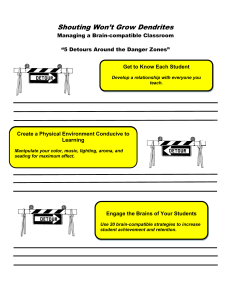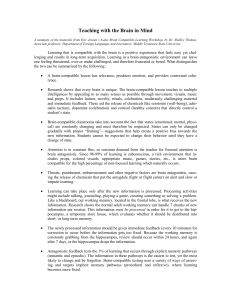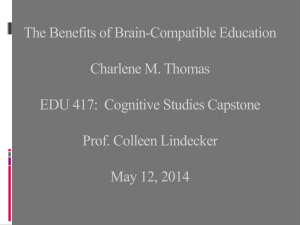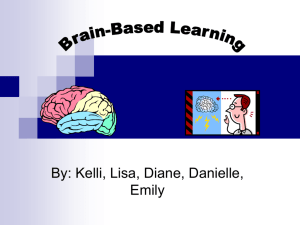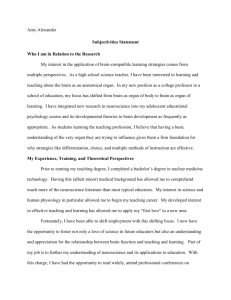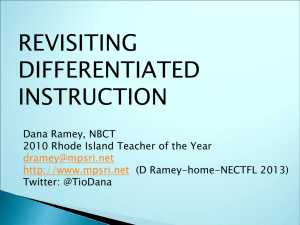File - Lisa Bitterman
advertisement
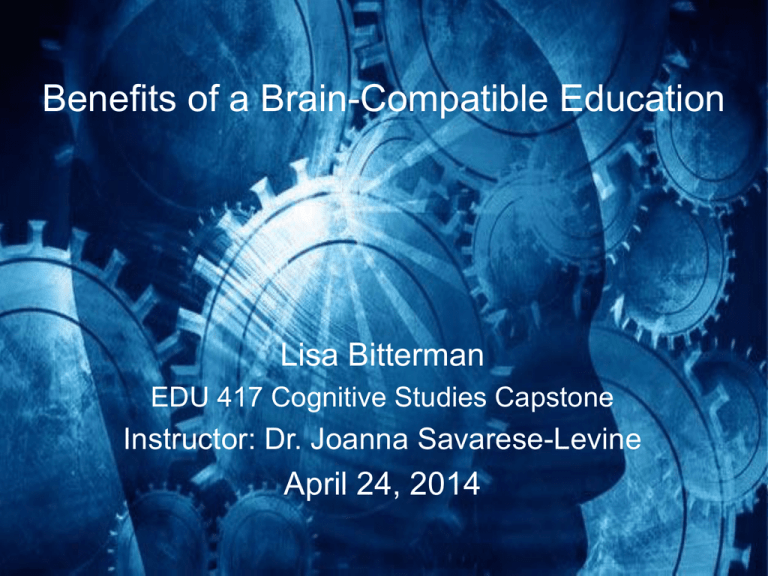
Benefits of a Brain-Compatible Education Lisa Bitterman EDU 417 Cognitive Studies Capstone Instructor: Dr. Joanna Savarese-Levine April 24, 2014 Benefits of a Brain-Compatible Education REALITY: a typical classroom of 20 students = 20 different learning preferences and styles. CHALLENGE: lesson plans must seek to satisfy all needs in some capacity. Traditional teaching utilizing formal approaches, memorization and rigidity is outdated. Brain-compatible education is “learning in accordance with the way the brain is naturally designed to learn” (Jensen, p. 4, 2008). Introduction My name is Lisa Active duty military family-Coast Guard Homeschool 4 year old Official courier of our 16 year old son BA in Cognitive Studies from Ashford University Educational Advocate-I’m here to help! Overview of Brain-Compatible Education • Advances in brain imaging and observation technology • Pinpoint areas where learning occurs as it happens • Neuroplasticity-the discover that the brain is plastic • Re-routing functions to other areas of the brain via intensive training. • Example: Dr. Edward Taub invented a plasticity-based treatment involving intensive “shaping” practices for stroke victims. • RESULTS: Many stroke patients have regained partial if not full functionality using his technique (Doidge, 2007). Compare/Contrast BCE and Traditional Instruction Brain-Compatible Traditional rote memorization based on theories of Pavlov, Skinner, Piaget, & Vygotsky Motivation Uses brain's natural desire to learn based on knowledge of brain physiology Understanding Factors That Impact Learning Genetics are important, namely the neurochemicals in the brain including dopamine, serotonin, and acetylcholine. Dopamine-is the “SAVE” button in the brain when learning occurs. It controls conscious motor activity and heightens arousal and awareness in students (Song & Fellous, 2014). Serotonin-the “feel good” chemical known for calming. Assists with notices cues, regulating emotions and behavior-which all contribute to our ability to focus and retain information (Fitzgerald, 2011). Acetylcholine-key to memory circuitry. We miss it when it’s gone… if we remember what it.. What.. Understanding Factors That Impact Learning Environmental factors influence neurotransmitter activity: • Example: poor nutrition devoid of consumption of amino acids will directly impact the efficiency of neurotransmitters in the brain making learning more difficult and not motivating. • Aerobic exercise gets blood pumping and increases oxygen=growth and plasticity of the frontal lobes of the brain (Wolfe, 2010, p. 93). Studies show that exercise and the subsequent release of BDNF (brain-derived neurotrophic factor) enhances learning and memory processes in people who have had strokes (Mang, Campbell, Ross, and Boyd, 2013). • Sleep-memory consolidation occurs during the REM stage of sleep. Consolidation: “process of stabilizing a memory trace over time, moving it from short to long-term memory” (Wolfe, 2010, p. 95). • Nutrition-nearly all neurotransmitters are made of amino acids which we get from food. The more amino acids ingested, the more effective these chemicals become. Information Processing Model and Learning Information Processing Model-explains how information is encoded, stored, and retrieved in memory (Wolfe, p. 110, 2010). STEP ONE: intake/sensory memory Information Processing Model and Learning Information Processing ModelSTEP TWO: Working memory/conscious processing Information Processing Model and Learning The Information Processing Model can be enhanced or inhibited by emotions! BENEFITS: • Material with an “emotional hook” evoke personal meaning and emotions for learners making it easier to recall the information later. • Fight or Flight: brain seeks fast response from our memories to find an appropriate response for the situation. • Memories are also made more vivid during heightened stages of stress. DETRIMENTS: • Extended periods of stress suppressed immunity from illness. • Too much stress and other negative emotions lower the ability to perform and pay attention in the classroom. Information Processing Model and Learning Information Processing ModelSTEP THREE: neural changes/long-term memory storage Example: Modified Activity (Brain-Compatible) *words that are underlined are part of the modifications made in order for the activity to be more brain-compatible* Middle Ages Activity: Option 1: Students will write a diary entry covering the span of 24 hours and "a day in the life of.." someone of their choosing (famous or not) from the Middle Ages including a brief description of their person. Students also have the option to write about a person from a pertinent photograph or drawing. Option 2: Students will either draw or build a castle that is meant to defend its’ kingdom from attack. Working in pairs or teams students will collaborate and build structures based on their knowledge of battles and siege warfare (popular strategy during the Middle Ages) and strive to build castles worthy of royalty and also strong enough to keep the enemy out. Why Pursue Brain-Compatible Education? Brain-compatible education is an exciting up-and-coming approach to education. Given it’s basis in neuroscience, which is an observable science, it is certain to gain momentum at some point and become more common and even mainstream. It is crucial to open up education and make it more meaningful for students of all capacities. Modifying existing lesson plans and activities will make them appeal to more students. Brain-compatible education has huge potential to nurture a love of learning in students and keep them motivated to become life-long learners. References Doidge, N. (2007). The Brain That Changes Itself. New York: Viking Penguin. Fitzgerald, P. (2011). A neurochemical yin and yang: Does serotonin activate and norepinephrine deactivate the prefrontal cortex? Psychopharmacology, 213(2/3), 171-182. doi: 10.1007/s00213-010-1856-1. Jensen, E. (2008). Brain-Based Learning: The New Paradigm of Teaching. (2nd Thousand Oaks, CA: Corwin Press. ed.). Jensen, E. (n.d.). Brain-Based Learning Strategies. Florida Education Association. Retrieved from http://feaweb.org/brain-based-learning-strategies Mang, C. S., Campbell, K. L., Ross, C. D., and Boyd, L. A. (2013). Promoting neuroplasticity for motor rehabilitation after stroke: Considering the effects of aerobic exercise and genetic variation on brain-derived neurotrophic factor. Physical Therapy, 93(12), 1707-1716. doi: 10.2522/ptj.20130053. References McDaniel, R. (2008, July 28). Brain based learning vs. traditional learning. Yahoo Voices. Retrieved file://localhost/from http/::voices.yahoo.com:brain-basedlearning-vs-traditional-learning-1717969.html Song, M. R. and Fellous, J. (2014). Value learning and arousal in the extinction of probabilistic rewards: The role of dopamine in a modified temporal difference model. Plos ONE, 9(2), 1-12. doi: 10.1371/journal.pone.0089494. Wolfe, P. (2010). Brain matters: Translating research into classroom practice. (2nd ed.). Alexandria, VA: Association for Supervision & Curriculum Development.
